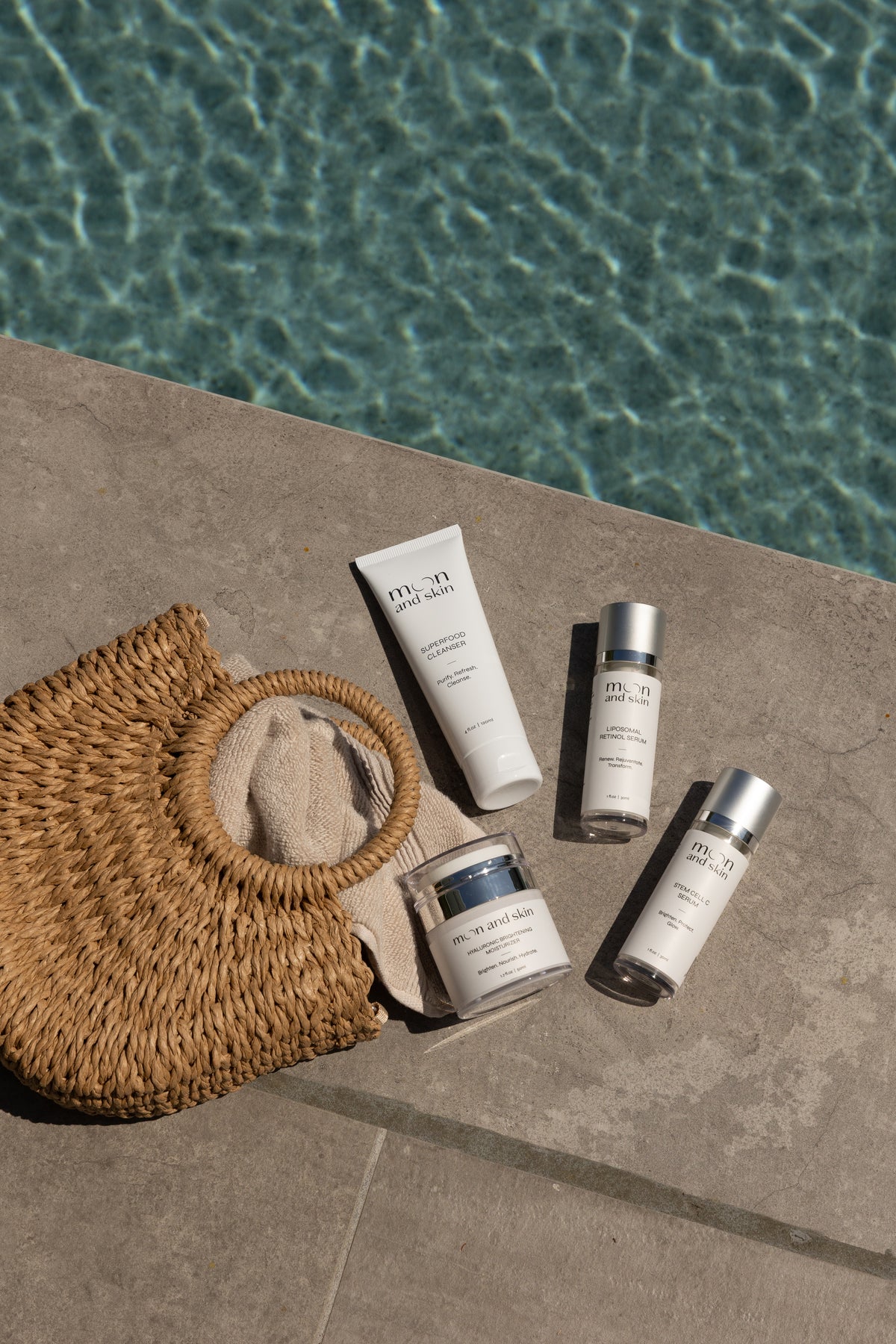Table of Contents
Introduction
If you've ever found yourself staring at dark spots on your skin, you're not alone. These blemishes, often caused by sun exposure, hormonal changes, or aging, can be frustrating and challenging to treat. You may have heard that vitamin E oil holds the key to fading these imperfections, but does it really work?
Vitamin E has long been touted as a miracle ingredient in skincare, known for its antioxidant properties and nourishing benefits. As we navigate the world of skincare, where misinformation is rampant, we understand that you may be seeking clarity on how vitamin E can impact dark spots. In this blog post, we will explore the science behind vitamin E, its benefits, and how it may help in the fight against dark spots, as well as practical steps to incorporate it into your skincare routine.
Together, we'll break down what dark spots are, how vitamin E functions in the skin, and what our product offerings at Moon and Skin can do to support your skincare journey. Our mission is to provide you with clean and thoughtful skincare for every phase of life, empowering you to make informed choices.
Let’s dive into the details of whether vitamin E truly clears dark spots and how you can harness its benefits for your skin.
Understanding Dark Spots
What Are Dark Spots?
Dark spots, also known as hyperpigmentation, occur when excess melanin, the pigment responsible for skin color, is produced in certain areas of the skin. This overproduction can result from various factors, including:
- Sun Exposure: UV radiation stimulates melanin production, leading to sunspots or age spots.
- Hormonal Changes: Conditions like melasma can cause dark patches, often triggered by pregnancy or hormonal therapies.
- Post-Inflammatory Hyperpigmentation: Acne scars or skin injuries can leave behind dark spots as they heal.
- Aging: As we grow older, the skin's ability to regenerate slows down, leading to uneven pigmentation.
Why Do We Get Dark Spots?
Understanding the underlying causes of dark spots is crucial in addressing their appearance. Here are some common culprits:
- UV Radiation: The sun is one of the leading factors in dark spot formation. Prolonged exposure can lead to localized overproduction of melanin.
- Hormonal Fluctuations: Women, especially during pregnancy or while using hormonal birth control, may experience melasma, characterized by dark patches on the face.
- Skin Conditions: Conditions such as eczema or psoriasis can lead to post-inflammatory hyperpigmentation.
- Medications: Certain medications can cause skin to become more sensitive to sunlight, increasing the risk of dark spots.
How Common Are Dark Spots?
Dark spots are incredibly common, particularly among those with lighter skin types or those who frequently get sunburned. Studies indicate that up to 90% of people over the age of 50 may experience some form of hyperpigmentation, making it a prevalent concern for many.
The Role of Vitamin E in Skincare
What is Vitamin E?
Vitamin E is a fat-soluble nutrient that acts as a powerful antioxidant in the body. It helps neutralize free radicals, which are unstable molecules that can damage cells and lead to premature aging. Vitamin E exists in several forms, but tocopherol and tocopheryl acetate are the most widely used in skincare.
How Does Vitamin E Benefit the Skin?
- Antioxidant Protection: Vitamin E protects the skin from oxidative stress caused by UV radiation and pollution, which can lead to skin damage and dark spots.
- Moisturization: It acts as an emollient, helping to retain moisture in the skin, thereby improving its overall texture and appearance.
- Wound Healing: Vitamin E is known to promote skin healing, which can be beneficial for post-inflammatory hyperpigmentation.
- Skin Barrier Support: By strengthening the skin barrier, vitamin E may help prevent further damage and irritation that can lead to dark spots.
Does Vitamin E Clear Dark Spots?
While vitamin E is praised for its skin benefits, the evidence on its effectiveness specifically in clearing dark spots is mixed. Some studies suggest that vitamin E may help reduce hyperpigmentation, particularly when used in combination with other ingredients like vitamin C. However, it is important to note that results can vary based on individual skin types and the nature of the dark spots.
Combining Vitamin E with Other Ingredients
At Moon and Skin, we believe in the power of thoughtful formulations. Combining vitamin E with other ingredients can enhance its effectiveness. For example:
- Vitamin C: Known for its brightening properties, vitamin C can work synergistically with vitamin E to combat dark spots and improve skin tone.
- Hyaluronic Acid: This ingredient hydrates and plumps the skin, allowing vitamin E to penetrate better and deliver its benefits.
Incorporating Vitamin E into Your Skincare Routine
How to Use Vitamin E Oil
- Patch Test: Always start with a patch test to ensure your skin reacts positively to vitamin E oil.
- Apply After Cleansing: Use a gentle cleanser, like our Superfood Cleanser, to prepare your skin for vitamin E application.
- Mix with a Carrier Oil: If you're using pure vitamin E oil, dilute it with a carrier oil like jojoba or almond oil to reduce the risk of irritation.
- Target Problem Areas: Apply the mixture to dark spots or areas of concern, gently massaging it into the skin.
- Leave On Overnight: For optimal results, allow the oil to absorb overnight.
Our Recommended Products
At Moon and Skin, we offer a range of products that incorporate the benefits of vitamin E and other powerful ingredients to support your skincare goals:
- Hyaluronic Brightening Moisturizer: Formulated with hyaluronic acid and kojic acid, it hydrates and brightens for a more even skin tone.
- Stem Cell C Serum: Features a stable form of vitamin C and plant-cell technology to brighten and protect the skin, complementing vitamin E's effects.
- Liposomal Retinol Serum: This product enhances skin renewal, helping to fade dark spots over time with minimal irritation.
You can explore our offerings in our Best Sellers collection to find products that suit your needs.
Additional Methods for Treating Dark Spots
Over-the-Counter Options
While vitamin E may contribute to improving the appearance of dark spots, various over-the-counter products can also help. Look for ingredients like:
- Hydroquinone: A skin-lightening agent that reduces melanin production.
- Retinoids: Promote cell turnover and can fade hyperpigmentation over time.
- Alpha Hydroxy Acids (AHAs): Exfoliate the skin, revealing brighter skin underneath.
Professional Treatments
For more stubborn dark spots, professional treatments may be required:
- Chemical Peels: Remove the top layers of skin to reduce pigmentation.
- Laser Therapy: Targets melanin directly, breaking up dark spots for a more even skin tone.
- Microdermabrasion: Gently exfoliates the skin, improving texture and tone.
Summary of Key Takeaways
- Dark spots are caused by an overproduction of melanin due to various factors such as sun exposure, hormonal changes, and aging.
- Vitamin E offers antioxidant protection, moisturization, and potential benefits for reducing hyperpigmentation, although results can vary.
- Combining vitamin E with other effective ingredients like vitamin C can enhance its effects.
- Incorporating vitamin E into your routine can be done safely with proper application techniques and our recommended products.
Conclusion
Navigating the world of skincare can be complex, especially when it comes to tackling dark spots. While vitamin E may not be the sole solution for clearing dark spots, it can play a vital role in your skincare arsenal, particularly when used alongside other effective ingredients.
At Moon and Skin, we are committed to providing clean and thoughtful skincare solutions for every phase of life. We encourage you to explore our Bundle & Save collection, where you can build a complete skincare routine that includes our top-rated products designed to support your skin's unique needs.
Together, let’s celebrate your skin’s journey, embracing its evolution while arming it with the best formulations available.
FAQ
1. How long does it take for vitamin E to show results on dark spots?
Results can vary widely based on individual skin types and the severity of the dark spots. Consistent use over several weeks or months may be necessary to see noticeable improvements.
2. Can I use vitamin E oil on oily skin?
While vitamin E can benefit oily skin, it may cause breakouts in some individuals. It’s best to conduct a patch test and consider mixing it with a carrier oil to dilute its potency.
3. Is it safe to use vitamin E oil daily?
Many people can use vitamin E oil daily, but if you experience irritation or breakouts, consider reducing frequency. Consult with a dermatologist for personalized advice.
4. What are the best ways to prevent dark spots?
Preventing dark spots involves using sunscreen daily, avoiding prolonged sun exposure, and maintaining a consistent skincare routine that includes antioxidant-rich products.
5. Are there any side effects of using vitamin E oil?
Most individuals tolerate vitamin E oil well, but allergic reactions can occur. Always conduct a patch test before full application. If you notice irritation, discontinue use.







